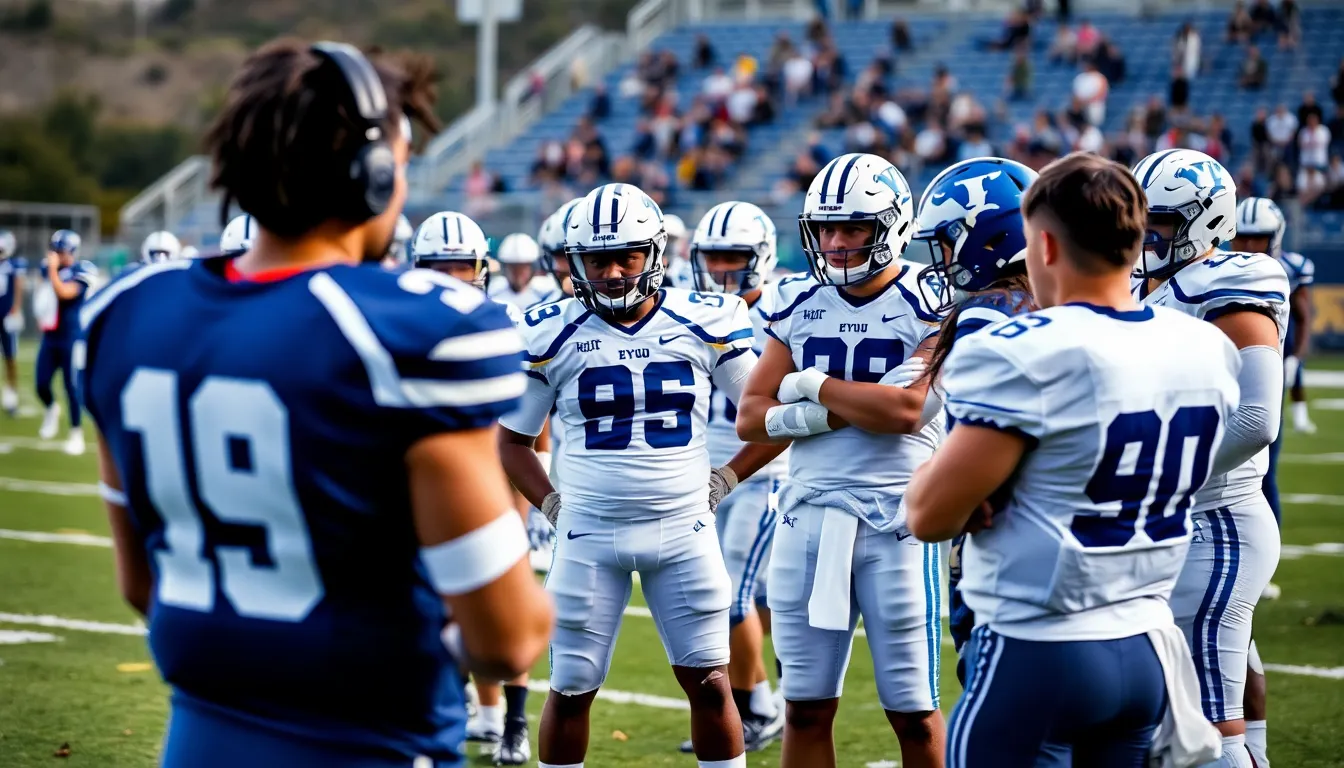When it comes to BYU football, injuries can feel like a plot twist in a suspenseful thriller. Just when fans think they’ve got the game figured out, a key player goes down, leaving everyone on the edge of their seats. It’s like watching a soap opera, but with more tackles and fewer dramatic pauses.
BYU Football Injury Report
Injuries play a significant role in the BYU football season, influencing team performance and player availability. Tracking the injury report provides critical insights for fans, coaches, and analysts. Several factors impact injury occurrences, including player position, training regimen, and game intensity.
Current injuries often dictate changes in starting lineups. Each week, the coaching staff evaluates player health, determining who can contribute on the field. Star players facing injuries generate heightened concern among fans, particularly if their absence affects game strategy.
Specific injuries can vary in severity. Common issues include ankle sprains, knee injuries, and concussions. Recovery timelines fluctuate based on individual cases, complicating predictions about a player’s return to action. Evaluations by medical staff ensure accurate and timely updates regarding each player’s status.
Communication with players is vital. Coaches often emphasize the importance of reporting any discomfort, promoting a culture of safety. Early detection and rest can minimize long-term impacts on athletes’ careers.
Fans engage with the injury report for a clear understanding of game readiness. Regular updates posted on team websites and social media channels keep supporters informed. These reports create a narrative around the team, highlighting resilience in facing adversity.
Monitoring the BYU football injury report presents a window into the highs and lows of the team’s journey. Adapting to injury setbacks tests the depth and strategy of the roster. As the season progresses, every new report reflects the ongoing battle between the desire to compete and the necessity of player health.
Key Injuries Impacting the Team

Injuries significantly affect BYU football, shaping game outcomes and team morale. Assessing current injuries reveals critical challenges.
Star Players Affected
Starting quarterback Jaren Hall faces a sprained ankle, which limits his mobility and decision-making abilities on the field. Star receiver Puka Nacua suffers from an ongoing hamstring issue, hindering his speed and route running. Defensive standout Max Tooley deals with a concussion that affects his participation in practices and game situations. The status of these key players influences offensive strategies and defensive formations, creating uncertainty for coaches and fans alike. Monitoring updates concerning their recovery is essential for anticipating game performance and potential lineup changes.
Positions Most Affected
Quarterback and wide receiver positions face the most challenges, often dictated by injuries. Both groups rely heavily on speed and agility, making them more vulnerable during intense matchups. Offensive linemen experience various injuries due to their physical role in protecting the quarterback and creating running lanes. Linebackers also find themselves susceptible to injuries, as they consistently engage in high-impact tackles. Collectively, these injured positions necessitate roster adjustments, complicating game plans and squad depth. Tracking the injury report closely remains crucial for understanding team dynamics and strategies.
Recovery Timelines and Updates
Monitoring injury recovery timelines is vital for understanding player availability. Current updates reveal varied recuperation schedules depending on the severity of injuries.
Expected Return Dates
Jaren Hall’s sprained ankle faces a recovery timeline of approximately four to six weeks. Puka Nacua’s hamstring issue could sideline him for three to four weeks, affecting offensive play. Max Tooley’s concussion evaluation remains ongoing and might see him return within a week. Timely assessments will provide fans with crucial information about these key players. If these players can’t rejoin the field by their expected return dates, coaches will need to devise alternative game plans.
Impact on Upcoming Games
Star injuries directly affect team dynamics and strategies. For instance, Hall’s absence influences the quarterback’s decision-making process, making offensive execution challenging. Without Nacua, the team lacks depth in passing options, impacting scoring potential. Tooley’s injury alters defensive formations, presenting opportunities for opposing offenses. Coaches may emphasize adjusted practices to prepare for matches without top players. Each game’s outcome depends significantly on how well the team adapts after these setbacks.
Coaching Strategies in Response to Injuries
Coaches face unique challenges when key players sustain injuries. Adjustments to game strategies often reflect the availability of star athletes. For instance, without starting quarterback Jaren Hall, offensive play calls may shift to emphasize a more conservative approach, relying on the running game.
Offensive coordinators frequently modify formations to accommodate player strengths. In Hall’s absence, they might lean on backup quarterbacks to execute simpler passing strategies. Such decisions aim to minimize risks while maximizing offensive efficiency.
Defensively, injuries to standout players like Max Tooley necessitate changes in on-field alignment. Safeties and cornerbacks may need to take on additional responsibilities, ensuring coverage remains strong despite personnel losses. Coaching staffs often emphasize communication and teamwork in these situations, reinforcing players’ confidence on the field.
Special teams also undergo scrutiny following injuries. Game plans may incorporate alternate players in key roles, such as return specialists. Coaches look for players who can deliver under pressure, maintaining performance during unexpected situations.
Monitoring recovery timelines plays a critical role in strategic planning. Knowing that players like wide receiver Puka Nacua may miss several weeks allows coaches to adapt practices accordingly. This foresight enables them to foster resilience within the team.
Detailed injury reports inform coaching decisions on a weekly basis. Data-driven insights contribute to the development of adaptable game plans, ensuring the team remains competitive. Strong leadership in moments of adversity enhances team dynamics and cultivates a winning mentality throughout the season.
Conclusion
The unpredictable nature of injuries in BYU football adds an intriguing layer to the season. With key players like Jaren Hall and Puka Nacua facing significant challenges, the team’s adaptability becomes essential. Fans remain engaged as they track recovery timelines and adjustments in strategy. The ongoing communication between coaches and players fosters a culture of resilience and safety.
As the season progresses, staying updated on the injury report will be crucial for understanding team dynamics. Each player’s return has the potential to shift game strategies and influence outcomes. The ability to navigate these challenges will ultimately define BYU’s performance and resilience throughout the season.

